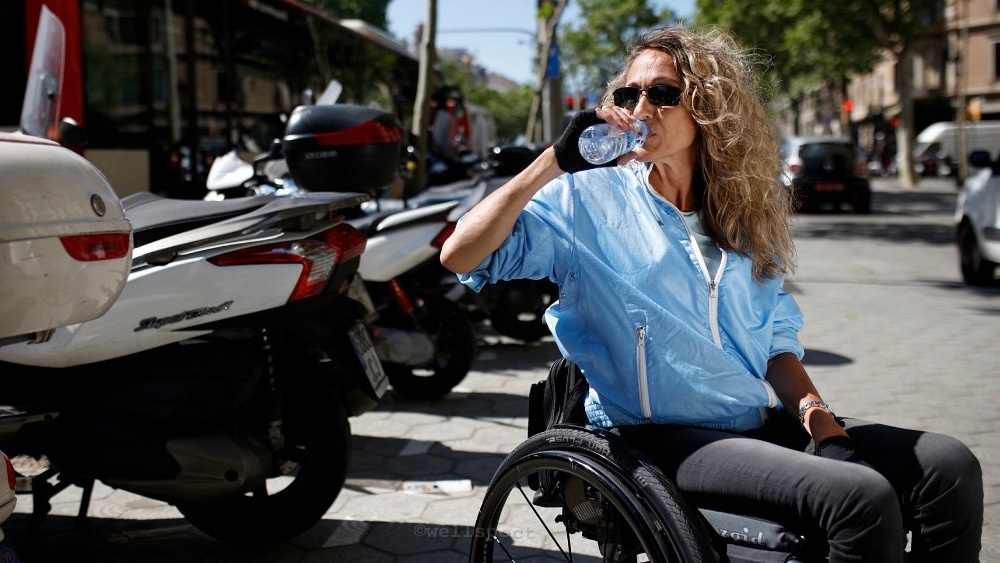Female urinary incontinence is a very common condition. It affects 1 in 4 women and means an involuntary loss of urine. As well as the physical effects of the condition, frequent accidents can lead to social discomfort or isolation. Let's take a look at what everyday life entails with respect to recognising and treating this issue, how can we recognise it and what solutions and treatments are available.

Urinary incontinence is a condition that mainly affects women. In fact, it occurs in women about 2.5-3 times more frequently than in men.
One of the causes for this increased incidence is the specific structure of the female pelvic floor. A woman's pelvic floor is more complex than the male one due to the anatomy required for childbirth.
Incontinence is characterised by a loss of urine with little or no control in the process. This can lead to uncomfortable situations and restrict one's lifestyle.
It is very important to learn how to recognise the symptoms and talk to your doctor about them. Identifying the specific causes is also the first step towards defining the most appropriate treatment. This will improve your quality of life.
Read this summary to find out what you can do when symptoms occur and what therapies and solutions are available.
What is urinary incontinence?
Urinary incontinence refers to the inability to control the loss of urine from the urethra. This can occur when and where you least expect it. This is the opposite condition of urinary retention, or the inability to pass urine or completely empty the bladder.
Symptoms of female urinary incontinence
To understand if urinary incontinence is the condition in question, there are some alarm bells to pay attention to. The main symptoms are:
- Sudden urine leakage when you cough, sneeze, or laugh.
- Leakage of urine when exercising, bending over or changing positions. For example, if you stand up from a sitting or lying position.
- Moments when the urge to urinate is so strong that you cannot control it before reaching a bathroom.
- Waking twice or more during the night to go to the bathroom, or find the bed wet upon awakening.
Urinary incontinence causes in females
Female urinary incontinence can be caused by several factors, including:
- Pregnancy and childbirth, which in some cases lead to a weakening of the pelvic floor.
- Menopause can lead to an increase in incidents of involuntary loss of urine. This is because it causes a decrease in the production of hormones. These hormones are important for maintaining the muscle tone of the pelvic area.
- Urinary or vaginal infections
- Side effects of drugs
- Side effects related to surgery
- Pelvic organ prolapse, which occurs when the pelvic floor muscles and other tissues weaken. This causes the organs to pop out of their normal position.
- Neurogenic bladder, caused by disease or injury such as multiple sclerosis, spina bifida, or spinal cord injury
Types of female urinary incontinence
Depending on the cause of urinary incontinence, we can talk about:
Stress incontinence
This occurs as a result of physical efforts that lead to increased pressure on the abdomen. Such efforts could include coughing and sneezing, lifting heavy objects, changing posture or sudden movements. It can be due to pregnancy, childbirth and menopause.
Urge incontinence
Also known as overactive bladder. This is when there is a sudden and intense urge to urinate, followed by the loss of urine. The bladder musculature contracts with very little "warning", which leaves no time to reach the bathroom.
The causes can vary from infections to the intake of substances that can irritate the bladder (such as drugs or food). Urge incontinence could also be the result of another condition. Examples of such conditions include Parkinson's, Alzheimer's, stroke, multiple sclerosis, and spinal cord injury.
Frequent or constant leakage
Frequent or constant leakage, due to the difficulty of completely emptying the bladder. The remaining urine, therefore, tends to escape after urination. This type of incontinence can occur in people suffering from damage to the bladder. It can also be caused by obstruction of the urethra or neurological damage caused by diabetes.
Mixed incontinence
This is when symptoms of multiple types of incontinence occur, for example, stress and urgency incontinence.
There are also some less common types:
- Functional incontinence: this is due to physical or neurological limitations that prevent you from reaching the bathroom in time.
- Total incontinence: in cases of continuous urinary leakage, or a recurrent loss of large quantities of urine. This can be caused by congenital anatomical defects, spinal cord injury, or urinary system injury.
Diagnosing female urinary incontinence
When the symptoms of incontinence occur, it is advisable to contact your doctor. They will be able to indicate a specialist to get a correct diagnosis and identify the causes, type and suitable treatment.
Nowadays there are some simple tests and assessments that allow us to understand the origin of the disorder. This could include self-assessment questionnaires and urodynamic investigations. Diagnosis may also require examination of the perineal muscles and ultrasound or radiographic studies of the lower urinary tract.

Most often, the path leading to diagnosis does not require invasive techniques. Usually, you will begin with an interview necessary to gather information on personal medical history. Then the specialist carries out a physical examination ranging from palpation of the abdomen to the verification of pelvic muscle tone. Following this, they may prescribe a series of specific, urodynamic and complementary clinical tests.
Other necessary basic tests, in addition to the medical history and urological examination, are:
- certain blood tests
- urinalysis
- urine culture
- ultrasound of the abdomen with an evaluation of the residual urine in the bladder after urinating.
These tests are used to confirm or exclude certain conditions. For example, the presence of urinary tract infections or other factors which could contribute to incontinence. Sometimes, other inquiries, such as a voiding diary, need to be added to these basic tests.
Treatment & prevention of female urinary incontinence
The prevention of female urinary incontinence
There is no single solution to prevent incontinence in all its forms. However, it is always useful to maintain a healthy lifestyle. This includes a balanced diet and a correct intake of fluids (about 1.5-2 litres of water per day). Exercising, avoiding alcohol and smoking, and an intake of caffeinated beverages in moderation can in some cases help prevent urinary leakage.

Pregnant women can try exercises and treatments to prepare the perineum to prevent any risks. Some relaxation and breathing strategies may also be helpful. It is always advisable to refer to specialised medical personnel to know which exercises are right for you.
Female urinary incontinence treatment
Once the type and causes of incontinence have been identified, it becomes possible to define a treatment path. This may include solutions such as:
- Pharmacological: In cases when the weakening of the sphincter tone is due, for example, to hormonal deficiency. This can be caused by menopause or infections such as cystitis or detrusor overactivity.
- Re-training of the pelvic floor: This is a series of exercises useful for strengthening the pelvic floor muscles. These muscles support the organs found in the abdominal cavity, including the bladder and urethra.
- Surgery: In specific cases, to restore support to the bladder and urethra.
Depending on the case, the therapeutic path identified by the specialist might include one or more solutions. For example, they might suggest pharmacological interventions alongside surgical ones and make use of specific aids.
Useful female urinary incontinence products
To avoid the smell and discomfort that may occur from the use of incontinence pads, a good alternative is the practice of intermittent catheterisation (IC). IC allows you to fully regain control of your daily routine. This leads to a progressive improvement in your quality of life, as the frequency of visits to the toilet decreases and you no longer need to be concerned with possible smells or wet clothes.

If you want to find the catheters that best suit your needs, you can get in touch with your healthcare professional to get training and free samples:
Request a sample of LoFric Elle
LoFric are intermittent catheters with smart features and discreet packaging. The unique Urotonic Surface Technology is in perfect balance with the body and enables intermittent catheterisation in a sustainable, safe and user-friendly way.
The content of this post is for informational purposes only and is not intended for product promotion or diagnosis. For any further information, Wellspect strongly recommends that you consult your specialist for all matters relating to your health or to answer any questions.
Bibliography
Mauro Menarini, Judit Timar, Blue Book. 201 responses to spinal cord injury, Mirano, La Colonna Onlus, 2016.
Sitography
- https://www.wellspect.co.uk/bladder-and-bowel-dysfunction/bladder/common-bladder-problems/urinary-incontinence/
- https://www.wellspect.co.uk/education/articles/dysfunctions-urinary-system/
- https://blog.wellspect.com/3-most-common-female-bladder-problems
- https://www.wellspect.co.uk/education/articles/luts-webinar/
- https://www.wellspect.co.uk/bladder-and-bowel-dysfunction/bladder/common-bladder-problems/